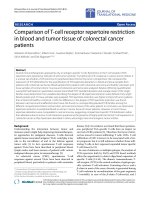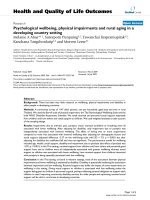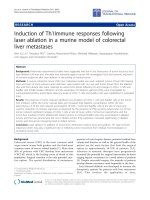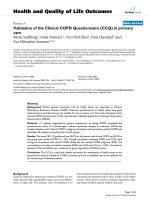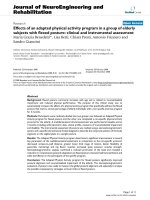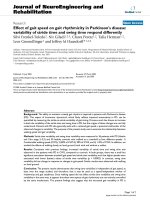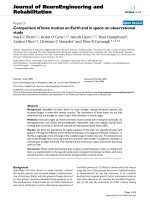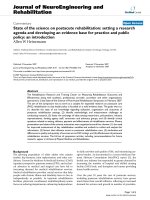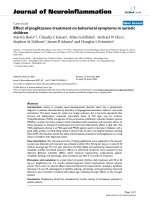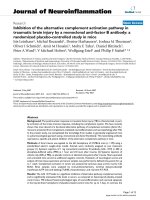báo cáo hóa học: " Initiation of health-behaviour change among employees participating in a web-based health risk assessment with tailored feedback" pptx
Bạn đang xem bản rút gọn của tài liệu. Xem và tải ngay bản đầy đủ của tài liệu tại đây (237.56 KB, 7 trang )
RESEARCH Open Access
Initiation of health-behaviour change among
employees participating in a web-based health
risk assessment with tailored feedback
Ersen B Colkesen
1,2
, Maurice AJ Niessen
2
, Niels Peek
2,3
, Sandra Vosbergen
3
, Roderik A Kraaijenhagen
2
,
Coenraad K van Kalken
2
, Jan GP Tijssen
1
, Ron JG Peters
1*
Abstract
Background: Primary prevention programs at the worksite can improve employee health and reduce the burden of
cardiovascular disease. Programs that include a web-based health risk assessment (HRA) with tailored feedback hold the
advantage of simultaneously increasing awareness of risk and enhancing initiation of health-behaviour change. In this study
we evaluated initial health-behaviour change among employees who voluntarily participated in such a HRA program.
Methods: We conducted a questionnaire survey among 2289 employees who voluntarily participated in a HRA
program at seven Dutch worksites between 2007 and 2009. The HRA included a web-based questionnaire,
biometric measurements, laboratory evaluation, and tailored feedback. The survey questionnaire assessed initial self-
reported health-behaviour change and satisfaction with the web-based HRA, and was e-mailed four weeks after
employees completed the HRA.
Results: Response was received from 638 (28%) employees. Of all, 86% rated the program as positive, 74%
recommended it to others, and 58% reported to have initiated overall health-behaviour change. Compared with
employees at low CVD risk, those at high risk more often reported to have increased physical activity (OR 3.36, 95%
CI 1.52-7.45). Obese employees more frequently reported to have increased physical activity (OR 3.35, 95% CI 1.72-
6.54) and improved diet (OR 3.38, 95% CI 1.50-7.60). Being satisfied with the HRA program in general was
associated with more frequent self-reported initiation of overall health-behaviour change (OR 2.77, 95% CI 1.73-
4.44), increased physical activity (OR 1.89, 95% CI 1.06-3.39), and improved diet (OR 2.89, 95% CI 1.61-5.17).
Conclusions: More than half of the employees who voluntarily participated in a web-based HRA with tailored
feedback, reported to have initiated health-behaviour change. Self-reported initiation of health-behaviour change was
more frequent among those at high CVD risk and BMI levels. In general employees reported to be satisfied with the
HRA, which was also positively associated with initiation of health-behaviour change. These findings indicate that
among voluntary participating employees a web-based HRA with tailored feedback may motivate those in greatest
need of health-behaviour change and may be a valuable component of workplace health promotion programs.
Introduction
Cardiovascular diseases (CVD) are the leading cause of
disability a nd death[1]. Much of the CVD burden could
be eliminated by addressing preventable risk factors,
including high blood pressure, hypercholesterolemia,
hyperglycaemia, smoking, physical inactivity, high fat
intake, and low fruit and vegetable intake [2,3]. The
health risk assessment (HRA) is one of the most widely
used strategies to stimulate changes in these factors
[4-6]. The worksite has been proposed as a suitable plat-
form for wide dissemination of prevention programs
that utilize HRA, with the advantage of cost savings, the
creation of a health-conscious environment and easier
follow-up of high-risk individuals [7,8].
The traditional HRA screened for risk factors to pro-
duce feedback that predominantly contained information
* Correspondence:
1
Department of Cardiology, Academic Medical Center - University of
Amsterdam, P.O. Box 22660, 1100 DD, Amsterdam, The Netherlands
Full list of author information is available at the end of the article
Colkesen et al. Journal of Occupational Medicine and Toxicology 2011, 6:5
/>© 2011 Colkesen et al; licensee BioMed Central Ltd. This is an Open Access article distributed under the term s of the Creative
Commons Attribution License ( which permits unrestricted use, distribution, and
reproduction in any medium, provi ded the original work is properly cited.
on the assessed risk[9]. However, reviews of the literature
did not always support effectiveness of t he traditional
HRA[9,10]. It was suggested that feedback merely con-
taining risk information would be insufficient to initiate
health-behaviour change[11]. It was acknowledged that
improvements in affecting health-behaviour change
could be achieved by web-based de livery of the HRA,
with incorporation of tailored health recommendations
[11-14]. These HRAs hold the advantage of simulta-
neously increasing awareness of risk and enhancing
initiation of health-behaviour change[11,15].
Despite this potential little has been documented regard-
ing health-behaviour change after implementation of a
web-based HRA with tailored feedback at the workplace.
In the present study we evaluated initial health-behaviour
change among employees who voluntarily participated in a
web-based HRA including tailored feedback, offered to
them by their employer as part of a worksite health man-
agement program. The HRA was designed to collect data
that are necessary to screen for the risk of a number of
preventable diseases, including CVD, and provide tailored
feedback to educate, motivate and empower participants
to engage in a better lifestyle and reduce CVD risk. The
primary aim of this study was to assess self-reported initia-
tion of health-behaviour change and associations with
satisfaction with the HRA and baseline health status.
Methods
Population and study procedure
We conducted a ques tionnaire survey among employees
who completed a web-based HRA with tailored feed-
back. This HRA was applied as part of a worksite health
management program at seven Dutch companies with
mainly white-collar workers between 2007 and 2009.
During this period 6790 employees were invited to com-
plete the HRA. E-mail invitations were sent by the
human resources department, with a single reminder
after two weeks. The invitation e-mail included a
description of the HRA and informed employees that
participation was voluntary, at no cost, that all personal
data would be t reated confi dentially, and that no results
would be shared with their employer or any other party.
Employees who completed the H RA, were sent an elec-
tronic satisfaction and health-behavio ur change ques-
tionnaire, four weeks after they had r eceived their
tailored feedback. The questionnaire measured overall
satisfaction with the HR A and initiation of health-beha-
viour change. It was sent to the employees using an e-
mail survey program, with a single reminder after o ne
week, and took about 10 minutes to complete.
The web-based HRA with tailored feedback
The H RA co nsiste d of four components: 1) a web-based
electronic health questionnaire, 2) biometric measurements,
3) laboratory evaluation, and 4) tailored health recom-
mendations, based on the results of the first three com-
ponents. The electronic health questionnaire includes
approximately 100 questions covering socio-demo-
graphics, personal health history, fami ly risk, and the
behavioural domain. All questions are derived from vali-
dated questionnaires and health-behaviour constructs
from the transtheoretical model,[16] protection motiva-
tion theory,[17] and social cognitive theory [18].
Biometric measurements (le ngth, weight, waist circum-
ference, blood pressure) are conducted at the worksite by
trained and certified staff, usually staff of the occupa-
tional health services provider of the employer. Measure-
ments are directly entered in the central HRA database.
At the same visit blood samples are collected for labora-
tory testing of total cholesterol, HDL, LDL, triglycerides,
glucose and HbA1C. Collected samples are shipped to a
certified laboratory where analyses are completed and
results are electronically transferred to the central HRA
database. For system security and data protection reasons
personal identification data and risk assessment data are
stored on separate servers. An electronic firewall is
placed between the servers and the Internet. Only users
certified by ID and password are able to access the ser-
vers. By computer-based combination of the assessed risk
with health-behaviour constructs, tailored health recom-
mendations are generated. These are presented to the
participant integrated within a web-based health action
plan. Each health plan comprises: 1 ) explanation o f the
assessed risk for each of the targeted preventable condi-
tions, using a three-colour system (green: normal risk
profile; orange: moderately elevated risk profile; red: ser-
iously elevated risk profile), 2) explanation of the threats
associated with elevated risk and potential gains of taking
preventive action, and 3) opportunities for taking preven-
tive action based on the participant’s stated motivation
for health-behaviour change (physical activity, smoking
cessation, alcohol intake, dietary habits), self-efficacy, and
preferences with respect to interventions (e.g. guided vs.
non-guided interventions). Where possible, recommen-
dations are based on prevailing practice guidelines. For
example, cardiovascular risk factor cut-off values are
derived from the European and Dutch guidelines for car-
diovascular risk management[19, 20]. When seriously ele-
vated risks are detected, the health plan includes referral
for further medical evaluation and treatment. A 30 min-
ute health counselling session with the program physi-
cian is also available upon request for all participants.
Satisfaction and initiation of health-behaviour change
questionnaire
The study questionnaire included seven questions exam-
ining satisfaction with the web-based HRA and initiation
of health-behaviour change after receiving the tailored
Colkesen et al. Journal of Occupational Medicine and Toxicology 2011, 6:5
/>Page 2 of 7
health advices. An outline of the items, questions, and
scoring scales are shown in the Additional file 1. Satis-
faction was measured with two questions, using evalua-
tive statements on the program as a whole: 1) overall
mark for the program, measured on a 5-point rating
scale, and 2) recommending the program to others,
measured on a 5-point agreement scale. Initiation of
health-behaviour change was measured with one item
that evaluated whether participants over all initiated
health-behaviour change after receiving their health
advices, followed by questions on which health-beha-
viour items change was initiated. Answer options were
yes, no, and not applicable.
Analysis
All analyses included descriptive statistics to examine
population characteristics, and questionnaire answers for
satisfaction and i nitial health-behaviour change. N on-
response bias was checked by comparing differences in
baseline values between responders and non-r espo nder s
to the s tudy questionnaire, using chi-squared tests. To
analyze the influence of demographic factors and health
characteristics on satisfaction with the HRA, logistic
regression analysis was performed, with dichotomized
Likert scale responses in positive and negative evalua-
tion as dependent variable and the variables of interest
(age category, sex, education level, body mass index as a
proxy for physical activity level and caloric intake, smok-
ing status, and Framingha m CVD ri sk score as a proxy
for cardiovascular risk factor levels) as covariates. The
Framingham score es timates 10-year CVD mortality and
morbidity risk by combining age, sex, blood pressure,
hypertension treatment status, total cholesterol, HDL-
cholesterol, smoking and diabetes status[21]. CVD risk
score was categorized in low, intermediate and high risk,
def ined as 10-year CVD risk of <10%, ≥10% to 20% and
≥20%. The influence of satisfaction with the HRA pro-
gram and health characteristics on initial health-beha-
viour change was also examined using logistic
regression. All analyses were adjusted for age, sex, and
education level. Data were analyzed using SPSS for Win-
dows, version 17.
Results
Of the 6790 invited employees, 2289 (34%) completed
all HRA measurements and received tailored health
advices. Approximately 30 days after receiving health
advices all 2289 employe es were sent the study ques-
tionnaire. The response rate was 28% (638/2289). There
were no differences between employees who responded
to the questionnaire and those who did not in sex, age
category, education level, F ramingham risk score, body
mass index, and smoking status (see Table 1). In Tables
2 and 3 results of the questionnaire are summarized. Of
all employees w ho responded to the questionnaire 86%
gave a positive ove rall rating and 74% recommended the
program to others. Overall, 368 (58%) employees
reported to have initiated health-behaviour change, 242
(38%) to have improved physical activity, 6 4 (10%) to
have reduced alcohol intake, and 282 (44%) to have
improved their diet. Twenty employees reported to have
quit smoking, representing 14% (20/145) of all current
smokers among the questionnaire responders.
In Table 4 the influence of demographic factors and
health characteristics on self-reported he alth-behaviour
change are summarized. Age category and sex did not
influence self-reported health-behaviour change. Com-
pared to those with a low education level, higher edu-
cated employees were less likely to reduce alcohol
intake (OR 0.50, 95% CI 0.25-0.99). Compared with
employees at low CVD risk, those at intermediate CVD
risk more often reported to have started to change their
health behaviour in general (OR 1.71, 95% CI 1.04-2.80),
whereas those at high CVD risk more oft en re ported to
have increased physical activity (OR 3.36, 95% CI 1.52-
7.45). Independently, overweight (OR 1.63, 95% CI 1.13-
2.36) and obese (OR 1.76, 95% CI 1.00- 3.10) employees
more frequently reported initiation of overall health-
behaviour change, and to ha ve increased their physical
activity (OR 1.56, 95% CI 1.03-2.36 for overweight and
OR 3.35, 95% CI 1.72-6.54 for obes e). Obese employees
also more often reported to h ave improved their diet
(OR 3.38, 95% CI 1.50-7.60). No associations between
smoking status and self-reported initiation of health-
behaviour change were found. An overall positive satis-
faction with the HRA was associated with more frequent
self-reported initiation o f overall health-behaviour
change (OR 2.77, 95% CI 1.73-4.44), increased physical
activity ( OR 1.89, 95% CI 1.06-3.39), and improved diet
(OR 2.89, 95% CI 1.61-5.17). Being positive on recom-
mending the program to others was similarly associated
with more frequent self-reported initiation of overall
health-behaviour change (OR 2.27 , 95% C I 1.57-3.29),
increased physical activity (OR 1.65, 95% CI 1.06-2.59),
and improved diet (OR 3.00, 95% CI 1.89 -4.78).
Reported satisfaction w ith the HRA was not related to
demographic factors and health characteristics with
(data not shown).
Discussion
The present study evaluated self-reported initial health-
behaviour change among employees who completed a
web-based HRA with tailored feedback. More than half
of the employees reported to have initiated overall
health-behaviour change. Initiation of more physical
activity and improved diet was more frequently reported
among those at high CVD risk and BMI levels. In gen-
eral, employees reported to be satisfied with the HRA,
Colkesen et al. Journal of Occupational Medicine and Toxicology 2011, 6:5
/>Page 3 of 7
and this was also positively associated with initiation of
health-behaviour change.
An important finding in the present study is that
employees at higher risk of CVD and high BMI levels
more frequently reported initiation of health-behaviour
change in general, increase in physical activity and
improved diet. These findings may imply that the pro-
gram is capable of stimulating health-behaviour change
among those at greatest need. A possible underlying
mechanism may be the tailoring of health advices to
individual health characteristics, stage of change[16],
motivation[17], and self-efficacy[18]. The feedback pro-
vided in the p rogram therefore migh t be less stigmatiz-
ing and better aligned with the intentions of the
participants, allowing them to change in small steps.
Table 1 Baseline characteristics of employees who completed the HRA and responded to the satisfaction and health-
behaviour change questionnaire and those who completed the HRA but did not respond the questionnaire
questionnaire
responders
n = 638
questionnaire
non-responders
n = 1651
p
Sex
Male 387(61%) 1017(62%) 0.679
Female 251(39%) 634(38%)
Age Category
<30 years 28(4%) 89(5%) 0.054
30-39 years 163(26%) 457(28%)
40-49 years 233(37%) 646(39%)
>50 years 214(34%) 459(28%)
Education level
Low 139(22%) 320(19%) 0.204
Midlevel 191(30%) 552(33%)
High 308(48%) 779(47%)
Framingham 10 year CVD risk score category
Low CVD risk (Framingham score < 10%) 455(71%) 1213(73%) 0.578
Intermediate CVD risk (Framingham score ≥ 10% - < 20%) 132(21%) 318(19%)
High CVD risk (Framingham score ≥ 20%) 51(8%) 120(7%)
Body Mass Index category
Normal weight: Body Mass Index < 25 kg/m
2
349(55%) 885(54%) 0.248
Overweight: Body Mass Index ≥ 25 - < 30 kg/m
2
221(35%) 620(38%)
Obese: Body Mass Index ≥ 30 kg/m
2
68(11%) 146(9%)
Current smoking status
non-smoker 493(77%) 1272(77%) 0.907
smoker 145(23%) 379(23%)
Values are expressed as number (% of total).
Table 2 Satisfaction scores of 638 employees who
completed the HRA and responded to the satisfaction
and health-behaviour change questionnaire
Satisfaction ratings
Positive Negative
Overall mark 546(86%) 92(14%)
Recommend to others 473(74%) 165(26%)
Values are expressed as number (% of total).
Positive for the satisfaction item “Overall mark” reflects the proportion rating
the item as excell ent, very good, or good, and negative reflects the
proportion rating the item as average or poor.
Positive for the satisfaction item “Recommend to others” reflects the
proportion rating the item as certainly yes or probably yes, and negative
reflects the proportion rating the item as maybe, probably no, and certainly
no.
Table 3 Self-reported initiation of health-behaviour-
change of 638 employees who completed the HRA and
responded to the satisfaction and health-behaviour
change questionnaire
Initiation of health-behaviour-
change after receiving health
advices
Yes No na
†
Initiated overall health-behaviour-
change after receiving tailored
health advices
368(58%) 243(38%) 27(4%)
More physical activity 242(38%) 212(33%) 184(29%)
Quit smoking 20(3%) 125(20%) 493(77%)
Reduced alcohol intake 64(10%) 198(31%) 376(59%)
Improved diet 282(44%) 158(25%) 198(31%)
Values are expressed as number of participants (%).
na
†
: Questionnaire responders who stated that health-behaviour change on
item of interest was not applicable.
Colkesen et al. Journal of Occupational Medicine and Toxicology 2011, 6:5
/>Page 4 of 7
These are factors that were previously associated with
poor satisfaction ratings of health services among those
at higher risk levels [9,12,14,22,23].
In the present study we found no influen ce of demo-
graphic factors and health characteristics on reported
satisfaction with the HRA. These findings are not con-
sistent with previous studies that evaluated satisfaction
in the context of a health service. Studies usually asso-
ciated higher age, fe male gender, and l ow educational
level with higher levels of satisfaction [22,24,25].
Table 4 Influences of demographic and health characteristics on self-reported initiation of health-behaviour change
Overall health-
behaviour change
More physical
activity
Quit
smoking
Reduced alcohol
intake
Improved
diet
OR [95% CI] OR [95% CI] OR [95% CI] OR [95% CI] OR [95% CI]
Sex
Male‡
Female 0.88[0.63 - 1.23] 1.20[0.82 - 1.76] 2.00[0.76 -
5.24]
0.89[0.47 - 1.69] 1.25[0.84 -
1.88]
Age
40-49 years‡
<30 years 1.05[0.47 - 2.36] 1.44[0.57 - 3.66] ** 1.67[0.39 - 7.07] 2.04[0.72 -
5.81]
30-39 years 0.92[0.61 - 1.39] 1.14[0.71 - 1.85] 1.66[0.53 -
5.25]
1.54[0.70 - 3.36] 1.00[0.61 -
1.63]
>50 years 1.39[0.94 - 2.06] 0.90[0.58 - 1.39] 0.55[0.17 -
1.83]
1.33[0.68 - 2.59] 1.13[0.70 -
1.81]
Education level
Low‡
Midlevel 1.08[0.69 - 1.70] 1.07[0.63 - 1.81] 1.37[0.36 -
5.20]
0.64[0.30 - 1.37] 1.10[0.62 -
1.96]
High 0.99[0.65 - 1.49] 1.20[0.74 - 1.94] 1.10[0.31 -
3.93]
0.50[0.25 - 0.99] 0.64[0.38 -
1.07]
Framingham 10 year CVD risk score (%)
Low CVD risk (Framingham score < 10%)‡
Intermediate CVD risk (Framingham score ≥
10% - < 20%)
1.74[1.10 - 2.74] 1.40[0.84 - 2.32] 1.83[0.48 -
7.02]
1.29[0.63 - 2.63] 1.11[0.65 -
1.90]
High CVD risk (Framingham score ≥ 20%) 1.82[0.92 - 3.59] 2.76[1.29 - 5.90] 3.88[0.80 -
18.75]
1.83[0.72 - 4.63] 1.03[0.47 -
2.29]
Body Mass Index category
Normal weight: Body Mass Index < 25 kg/m2
‡
Overweight: Body Mass Index ≥ 25 - < 30 kg/
m
2
1.63[1.13 - 2.36] 1.56[1.03 - 2.36] 0.89[0.29 -
2.68]
1.69[0.91 - 3.14] 1.44[0.93 -
2.23]
Obese: Body Mass Index ≥ 30 kg/m
2
1.76[1.00 - 3.10] 3.35[1.72 - 6.54] 2.57[0.42 -
15.81]
1.20[0.45 - 3.19] 3.38[1.50 -
7.60]
Current smoking status
non-smoker‡
smoker 1.03[0.70 - 1.51] 0.89[0.58 - 1.38] †† 1.36[0.74 - 2.49] 0.93[0.59 -
1.47]
Satisfaction
Negative overall mark‡
Positive overall mark 2.77[1.73 - 4.44] 1.89[1.06 - 3.39] 0.70[0.17 -
2.85]
1.56[0.64 - 3.79] 2.89[1.61 -
5.17]
Negative recommend to others‡
Positive recommend to others 2.27[1.57 - 3.29] 1.65[1.06 - 2.59] 0.53[0.19 -
1.46]
1.42[0.73 - 2.77] 3.00[1.89 -
4.78]
OR: Odds ratio. 95% CI: 95% confidence interval.
‡: Reference category.
*: OR could not be calculated because none of the responders at age <30 years reported quit smoking.
†: OR for reporting quit smoking between smokers and non-smokers is irrelevant.
ORs for Framingham score, Body Mass Index, and Smoking status were adjusted for age, sex, and education level.
Colkesen et al. Journal of Occupational Medicine and Toxicology 2011, 6:5
/>Page 5 of 7
However, previous sa tisfaction studies generally evalu-
ated a service that wa s based on face-to-face encounters
with health professionals. The web-based HRA program
we studied is a highly automated health service that
includes a face-to face encounte r with professionals
upon request or when medically necessary. These char-
acteristics may be relevant in designing HRA programs
to reach higher satisfaction, and consequently greater
health-behaviour change.
The present study has several limitations. First, the
response rate to the questionnaire was 28%, which is
lower than the mean response rates of 6 0% to 67% in
most satisfaction surveys[26,27]. However, our response
rate is comparable with response rates of general e-mail
health surveys, which are around 34%[28]. Moreover, we
did not find any differences in demographic and health
parameters between respond ers and non-responders to
the questionnaire. Therefore we assume that the sample
was representative for all participants of the HRA pro-
gram. Second, participation i n the HRA was voluntary,
with a participation rate of 34%. S tudies that evaluated
HRA or health promotion programs reported participa-
tion rates from 20% to 76%,[29,30] with the general
impression that females, older employees, and mainly
the “worried well” are attracted[31]. Although the parti-
cipation rate in this study is within the expected range,
we cannot rule out that among non-participants in the
HRA there were employees with less favourable health
characteristics. Third, both satisfaction and health-b eha-
viour change were self-reported and therefore may be
due to a number of psychosocial artefacts, including
social desirability bias and a novelty effect[22,25].
Finally, the high positive satisfaction rating for overall
mark may be skewed, because an unbalanced Likert
scale with 3 positive scores and 2 negative scores was
used. However, a previous study using a comparable
scale reported an overall positive rating of 84%, which is
similar with our findings[15]. Furthermore, we found
that the item “recommend to others” ,whichwas
assessed on a balanced scale, was also rated positive by
the majority of the participants and had similar influ-
ence on self-reported initiation of health-behaviour
change. Therefore, we assume that the impact of the
unbalanced scale was marginal.
Conclusion
More than half of the employees who voluntarily partici-
pated in a web-based HRA with tailored feedback,
reported to have initiated health-behaviour change
within four weeks after receiving their feedback. Self-
reported initiation of health-behaviour change was more
frequent among those at hi gh CVD ri sk and with high
BMI levels. In general, employees reported to be s atis-
fied with the HRA, which was also positively associated
with initiation of health-behaviour change. These find-
ings indicate that among voluntary participating employ-
ees, a web-based HRA program with tailored feedback
could motivate those in greatest need of health-beha-
viour change. A web-based HRA with tailored feedback
could therefore be a valuable component of workplace
health promotion programs.
Additional material
Additional file 1: Outline of the study questionnaire.
Acknowledgements
We thank all employees of the study worksites for their participation.
Author details
1
Department of Cardiology, Academic Medical Center - University of
Amsterdam, P.O. Box 22660, 1100 DD, Amsterdam, The Netherlands.
2
NDDO
Institute for Prevention and Early Diagnostics (NIPED), Amsteldijk 194, 1079
LK Amsterdam, The Netherlands.
3
Department of Medical Informatics,
Academic Medical Center - University of Amsterdam, P.O. Box 22660, 1100
DD, Amsterdam, The Netherlands.
Authors’ contributions
RJGP and JGPT were the principal investigators of the study, developed the
concept and design of the study, and contributed to the inter pretation of
data. EBC carried out the data collection, data analyses, performed the main
writing and drafted the manuscr ipt. MAJN carried out statistical analyses
under supervision of NP. EBC, MAJN, and SV drafted the manuscript. RAK,
CKvK and NP participated in coordination of the study. All authors reviewed
a previous version of the manuscript and vouch for the accuracy and
completeness of the data and analyses.
Funding
A Ph.D. grant for EBC and study materials were funded by NIPED.
Competing interests
CKvK and RAK are directors and co-owners of NIPED. This institute
developed the studied program and currently markets it in the Netherlands.
For the present study NIPED provided for a Ph.D. grant for EBC.
MAJN is a full-time employed as researcher by NIPED. NP is part-time
employed by NIPED as head of the research department and part-time
employed at the Academic Medical Center - University of Amsterdam as
assistant professor. All other authors are employed by the Academic Medical
Center - University of Amsterdam. They received no additional funding for
this study and report no competing interests.
Received: 29 August 2010 Accepted: 9 March 2011
Published: 9 March 2011
References
1. Allender S, Scarborough P, Peto V, Rayner M, Leal J, Luengo-Fernandez R,
et al: European cardiovascular disease statistics 2008. 1-2-2008. British
Heart Foundation Health Promotion Research Group Department of Public
Health, University of Oxford, European Hart Network, Ref Type: Generic.
2. Yach D, Hawkes C, Gould CL, Hofman KJ: The global burden of chronic
diseases: overcoming impediments to prevention and control. JAMA
2004, 291:2616-2622.
3. Yusuf S, Hawken S, Ounpuu S, Dans T, Avezum A, Lanas F, et al: Effect of
potentially modifiable risk factors associated with myocardial infarction
in 52 countries (the INTERHEART study): case-control study. Lancet 2004,
364:937-952.
4. Boulware LE, Marinopoulos S, Phillips KA, Hwang CW, Maynor K,
Merenstein D, et al: Systematic review: the value of the periodic health
evaluation. Ann Intern Med 2007, 146:289-300.
Colkesen et al. Journal of Occupational Medicine and Toxicology 2011, 6:5
/>Page 6 of 7
5. Pelletier KR: A review and analysis of the clinical and cost-effectiveness
studies of comprehensive health promotion and disease management
programs at the worksite: update VII 2004-2008. J Occup Environ Med
2009, 51:822-837.
6. Wonderling D, Langham S, Buxton M, Normand C, McDermott C: What can
be concluded from the Oxcheck and British family heart studies:
commentary on cost effectiveness analyses. BMJ 1996, 312:1274-1278.
7. Carnethon M, Whitsel LP, Franklin BA, Kris-Etherton P, Milani R, Pratt CA,
et al: Worksite wellness programs for cardiovascular disease prevention:
a policy statement from the american heart association. Circulation 2009,
120:1725-1741.
8. Goetzel RZ, Ozminkowski RJ: The health and cost benefits of work site
health-promotion programs. Annu Rev Public Health 2008, 29:303-323.
9. Soler RE, Leeks KD, Razi S, Hopkins DP, Griffith M, Aten A, et al: A
systematic review of selected interventions for worksite health
promotion. The assessment of health risks with feedback. Am J Prev Med
2010, 38:S237-S262.
10. Anderson DR, Staufacker MJ: The impact of worksite-based health risk
appraisal on health-related outcomes: a review of the literature. Am J
Health Promot 1996, 10:499-508.
11. Cowdery JE, Suggs LS, Parker S: Application of a Web-based tailored
health risk assessment in a work-site population. Health Promot Pract
2007, 8:88-95.
12. Kreuter MW, Strecher VJ: Do tailored behavior change messages enhance
the effectiveness of health risk appraisal? Results from a randomized
trial. Health Educ Res 1996, 11:97-105.
13. Kreuter MW, Strecher VJ, Glassman B: One size does not fit all: the case
for tailoring print materials. Ann Behav Med 1999, 21:276-283.
14. Noar SM, Benac CN, Harris MS: Does tailoring matter? Meta-analytic
review of tailored print health behavior change interventions. Psychol
Bull 2007, 133:673-693.
15. Suggs LS, Cowdery JE, Carroll JB: Tailored program evaluation: Past,
present, future. Eval Program Plann 2006, 29:426-432.
16. Prochaska JO, Velicer WF: The transtheoretical model of health behavior
change. Am J Health Promot 1997, 12:38-48.
17. Floyd DL, Prentice-Dunn S, Rogers RW: A meta-analysis of research on
protection motivation theory. Journal of Applied Social Psychology 2000,
30:407-429.
18. Bandura A: Self-Efficacy: The Exercise of Control
New York, NY: WH Freeman
& Co; 1997.
19. Burgers JS, Simoons ML, Hoes AW, Stehouwer CD, Stalman WA: [Guideline
‘Cardiovascular Risk Management’]. Ned Tijdschr Geneeskd 2007,
151:1068-1074.
20. Graham I, Atar D, Borch-Johnsen K, Boysen G, Burell G, Cifkova R, et al:
European guidelines on cardiovascular disease prevention in clinical
practice: executive summary. Eur Heart J 2007, 28:2375-2414.
21. D’Agostino RB Sr, Vasan RS, Pencina MJ, Wolf PA, Cobain M, Massaro JM,
et al: General cardiovascular risk profile for use in primary care: the
Framingham Heart Study. Circulation 2008, 117:743-753.
22. Harting J, van Assema P, de Vries NK: Patients’ opinions on health
counseling in the Hartslag Limburg cardiovascular prevention project:
perceived quality, satisfaction, and normative concerns. Patient Educ
Couns 2006, 61:142-151.
23. Kroeze W, Werkman A, Brug J: A systematic review of randomized trials
on the effectiveness of computer-tailored education on physical activity
and dietary behaviors. Ann Behav Med 2006, 31:205-223.
24. Aharony L, Strasser S: Patient satisfaction: what we know about and what
we still need to explore. Med Care Rev 1993, 50:49-79.
25. Sitzia J, Wood N: Patient satisfaction: a review of issues and concepts.
Soc Sci Med 1997, 45:1829-1843.
26. Asch DA, Jedrziewski MK, Christakis NA: Response rates to mail surveys
published in medical journals. J Clin Epidemiol 1997, 50:1129-1136.
27. Sitzia J, Wood N: Response rate in patient satisfaction research: an
analysis of 210 published studies. Int J Qual Health Care 1998, 10:311-317.
28. Jones R, Pitt N: Health surveys in the workplace: comparison of postal,
email and World Wide Web methods. Occup Med (Lond) 1999, 49:556-558.
29. Dobbins TA, Simpson JM, Oldenburg B, Owen N, Harris D: Who comes to a
workplace health risk assessment? Int J Behav Med 1998, 5:323-334.
30. Robroek SJ, van Lenthe FJ, van EP, Burdorf A: Determinants of
participation in worksite health promotion programmes: a systematic
review. Int J Behav Nutr Phys Act 2009, 6:26.
31. Lerman Y, Shemer J: Epidemiologic characteristics of participants and
nonparticipants in health-promotion programs.
J Occup Environ Med
1996, 38:535-538.
doi:10.1186/1745-6673-6-5
Cite this article as: Colkesen et al.: Initiation of health-behaviour change
among employees participating in a web-based health risk assessment
with tailored feedback. Journal of Occupational Medicine and Toxicology
2011 6:5.
Submit your next manuscript to BioMed Central
and take full advantage of:
• Convenient online submission
• Thorough peer review
• No space constraints or color figure charges
• Immediate publication on acceptance
• Inclusion in PubMed, CAS, Scopus and Google Scholar
• Research which is freely available for redistribution
Submit your manuscript at
www.biomedcentral.com/submit
Colkesen et al. Journal of Occupational Medicine and Toxicology 2011, 6:5
/>Page 7 of 7
